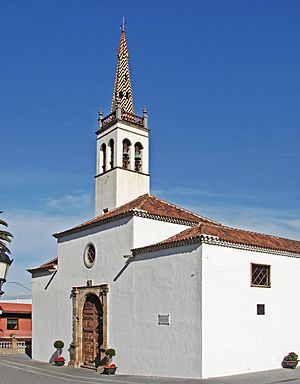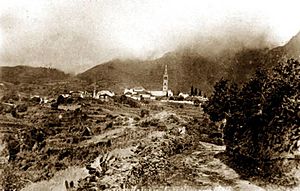Church of St James, Los Realejos facts for kids
Quick facts for kids Church of St James, Los Realejos |
|
|---|---|
|
Parroquia Matriz del Apóstol Santiago
|
|

Church of St James, Los Realejos
|
|
| Religion | |
| Affiliation | Roman Catholic |
| Province | Diocese of San Cristóbal de La Laguna |
| Ecclesiastical or organizational status | Parish |
| Location | |
| Location | Los Realejos, Spain |
| Architecture | |
| Groundbreaking | 1496 |
The Church of St James (Spanish: Parroquia Matriz del Apóstol Santiago) is an important Roman Catholic church. You can find it in the town of Los Realejos, on the island of Tenerife, Spain.
This church was first started way back in 1496. It is dedicated to Saint James the Apostle, who is the patron saint of Spain. Because of its history and beauty, it was officially named a national monument of Spain in 1983.
Contents
How the Church Began
The Church of St James was one of the very first religious buildings built in Tenerife. This happened after a long period of wars to take back land in Spain, known as the Reconquista.
After the Conquest of the Canary Islands, a leader named Alonso Fernández de Lugo wanted to show his thanks. He decided to build a special place for Saint James the Apostle. Many towns, like Gáldar, already had a special connection to Saint James.
On July 25, 1496, which is Saint James's special day, nine local kings from the Guanchen people were baptized there. These kings included Adjona, Añaterve, and Beneharo.
In 1542, a bishop named Diego de Muros wrote about the church. He mentioned that land was given to the church of "...Santiago del Realejo de arriba" to help the Taoro region.
The First Church Building
Sadly, old records from that time are missing. But people believe that in 1496, a simple building with a straw roof was put up. This would make it the very first Christian church on Tenerife.
The door on the north side of the church today was built much later, in 1570. It was carved by a person named Juan Benítez and is called the "Jacobean doorway."
In 1591, an inventory listed what the church had. It had three main altars. The biggest one had an old image of Saint James as a traveler. Other altars were for Bartholomew the Apostle, Benedict of Nursia, and Anthony of Padua. There was also one for Our Lady of Los Remedios. The church also had paintings of Saint Sebastian and Saint Michael, along with many valuable items made of gold and silver. The list also mentioned a wooden choir, an organ, and a pulpit.
Building the Church We See Today
The church building you see now started to take shape in the 1600s. The old 16th-century building was falling apart. So, in 1604, the same person who made the first stone doorway in 1570 was hired again. His job was to take down the "Old church" and build a new one.
The new design made the main part of the church, called the nave, bigger. It also added chapels on both sides of the transept (the part that crosses the main nave). Some materials from the old church were reused, and new stone came from the quarries of Tigaiga.
Expanding the Church
In 1610, the "nave del Evangelio" (which means "nave of the Gospel") was finished on the north side. This part had a special chapel for Our Lady of the Rosary. What used to be the main door to the nave became the entrance to this new chapel.
The south side, called the "nave de la Epístola" (meaning "nave of the Epistle"), was finished in 1626. A stonemason from Portugal, Manuel Penedo, took down the old outer wall and built the new nave. He used stone from the quarries of Acentejo. By 1667, when the chancel (the area around the altar) was rebuilt, all parts of the very first church were gone.
Roof and Tower Details
The roof was made with wood from Tigaiga, showing how important the main nave was. It had a special design with a cross frame and covered sections called coffers. Gold and colorful paint, done by master Andrés Gómez, decorated it. The roofs of the side chapels were simpler but had a similar design.
The church tower on the left side was built in 1774. It replaced the original tower. The top part of the tower, called the spire, is covered in ceramic tiles in a special style called Mudéjar.
By the end of the 1700s, the church looked much like it does today. It has three naves (main sections) that are all the same height. Each nave has its own roof, decorated with traditional Mudéjar art.
Inside the church, you can see beautiful statues. These include Our Lady of Remedies (Los Realejos), made by the sculptor Fernando Estévez. There is also El Nazareno (Los Realejos), created by Martín de Andújar Cantos.
In 1922, because parts of the church were getting old, the stone arches and columns were replaced. New concrete ones were put in, with decorative tops called Ionic capitals. In the 1960s, the main nave was made even bigger, and two new side chapels were added.
See also
 In Spanish: Parroquia matriz del Apóstol Santiago (Los Realejos) para niños
In Spanish: Parroquia matriz del Apóstol Santiago (Los Realejos) para niños
- Historical information on parish priests
- Fiestas de la Cruz
- Sebastián Fernández Méndez
- Treaty of Los Realejos


